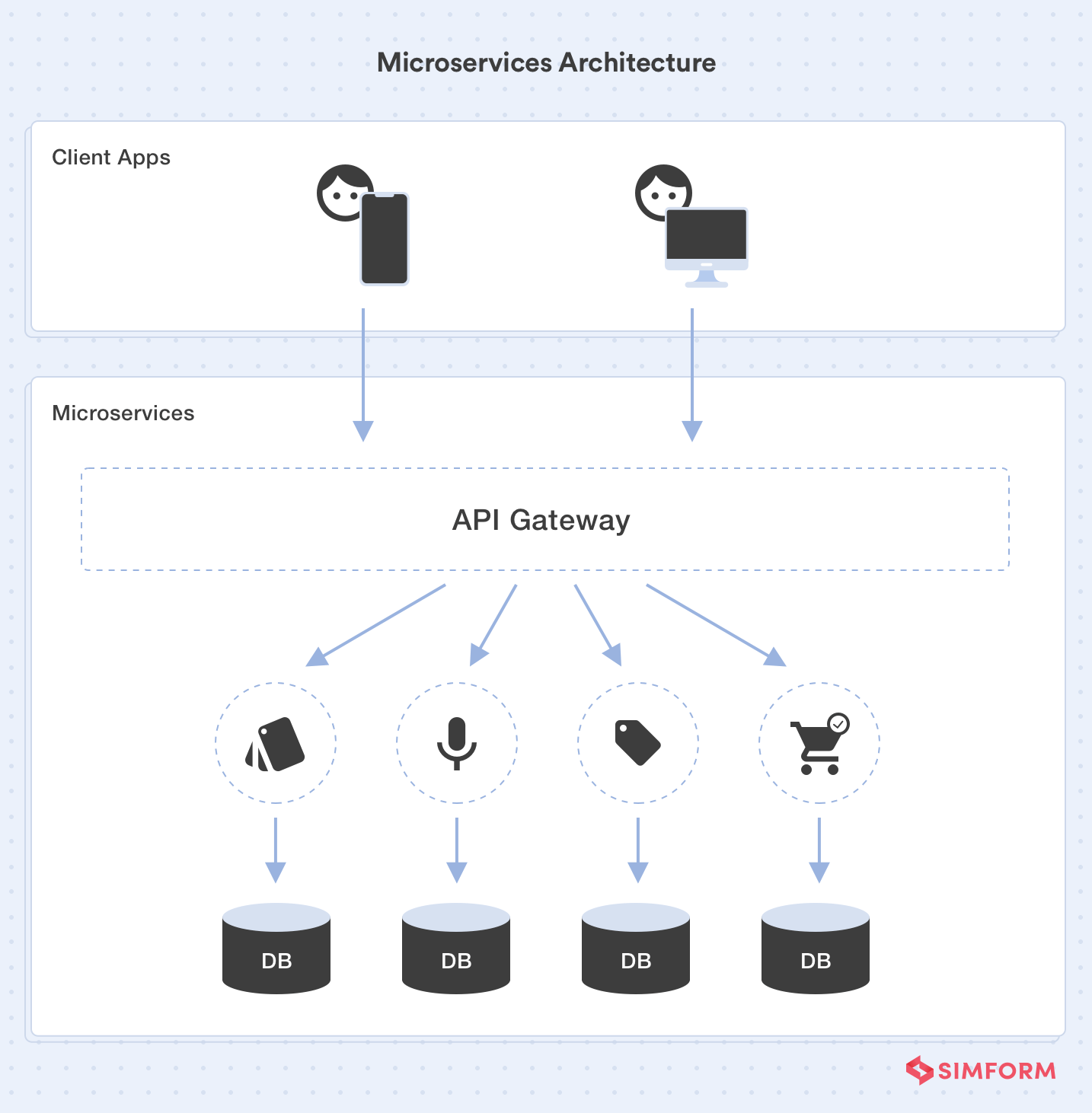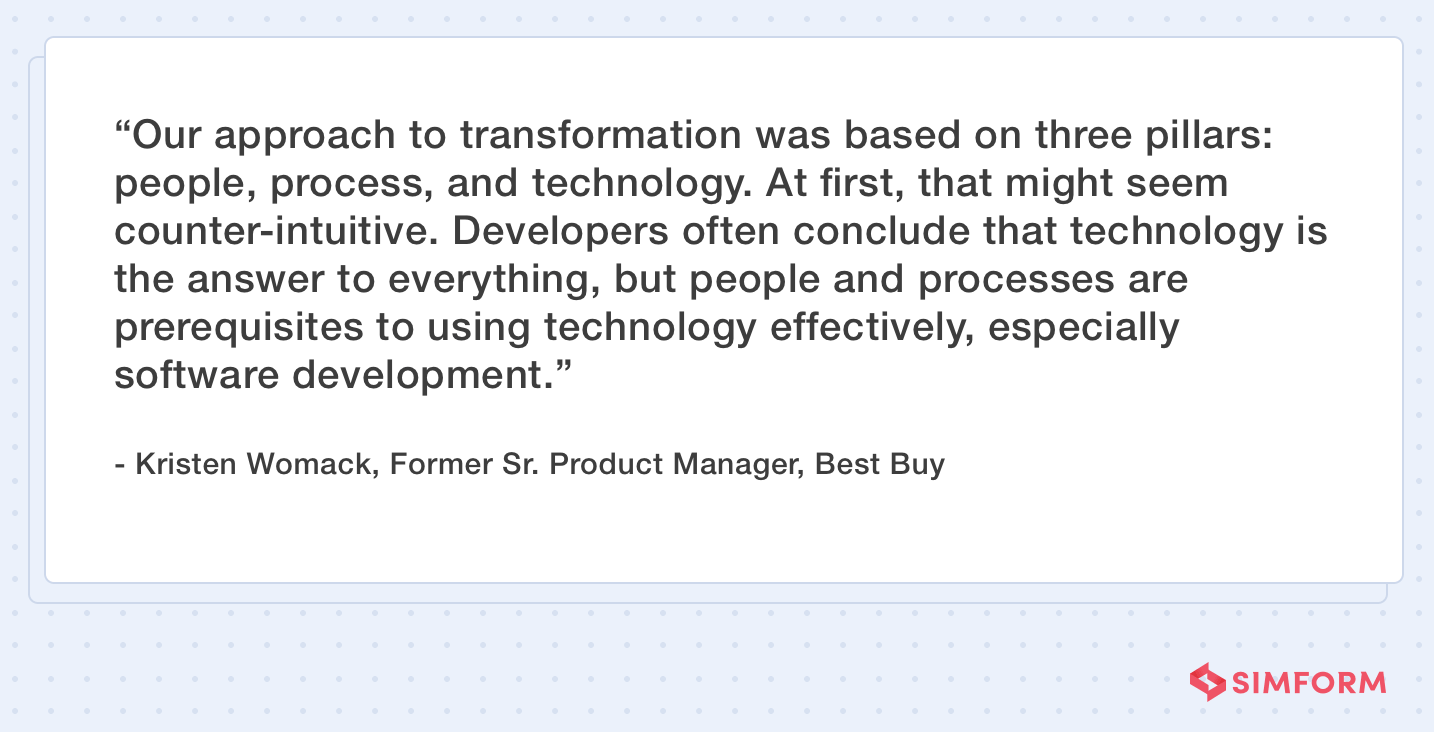What are microservices?
Microservice architecture is a software design pattern that decomposes the extensive app into various independent services that interact via APIs. As a result, you can have an autonomous team for developing and maintaining independent services, so scaling becomes easier.
You can also think of microservices as an extension of SOA (Service-Oriented Architecture). You can create various independent services using different programming languages and platforms. It enables the rapid, frequent, and reliable delivery of large and complex applications.
In short, microservices are a collection of services that are:
- Loosely coupled
- Highly maintainable and testable
- Organized around business capabilities
- Independently deployable
- Owned by a small team

Many organizations have embraced Conway’s Law to leverage the power of distributed teams and create efficient microservice architecture. Given below are some common characteristics that most microservice architectures exhibit.
Characteristics of microservices
- Each service has a separate database layer, independent codebase, and CI/CD tooling sets.
- Services are responsible for preserving their data or external state.
- Every service is independently deployable and can be tested in isolation without depending on other services.
- Internal communication between the services happens via well-defined APIs or any lightweight communication protocol.
- Each service can select the technology stack, libraries, and frameworks best suited for its use cases.
- Services should implement Retry functionality if there is a network or system failure.
Before building a microservice, you must also know the myths and confusions to enjoy the whole range of benefits that we’ll discuss later on.
Comparison of Microservices with Monolithic and SOA architecture
Three popular architectures — monolithic, service-oriented architecture, and microservices are mostly used to build a new application. We’ve already discussed microservices earlier, now let’s understand the other two.
Monolithic architecture – A monolithic application is developed as a single unit, where all features, functionality, and modules are tightly coupled for development, integration, and deployment.
Microservices vs monolithic
| Microservices | Monolithic | |
| Design | Independent services communicate via APIs | Complex app encompasses several tightly-coupled functions |
| Data consistency | Difficult to achieve | Easy to achieve |
| Scalability | Independently scalable | Challenging |
| Agility | High operational agility | Difficult to achieve operational agility |
| Service startup | Relatively quick | Takes more time |
| Finding failure points | Difficult | Easy |
| Team communication | More complex | Comparatively straightforward |
Service-oriented architecture – Created as a response to the traditional architectural approach, SOA helps decouple an overall application into smaller modules. These separate service modules intercommunicate to meet particular business requirements.
Often, many developers consider microservices as a subtype of SOA, while others insist each solves a different set of problems.
Microservices vs SOA
What are the benefits of microservices?
Microservices sit well with both cloud and DevOps. Let’s see how. Most companies nowadays are migrating their workloads to the cloud. Microservices in software development teams to use patterns like event-driven programming and autoscale scenarios. The businesses also exhibit the same enthusiasm for adopting the DevOps strategy. DevOps practices also work by breaking large problems into smaller pieces and solving them one at a time. As a result, microservices perfectly fit into the DevOps.
Also, microservices provide independent scaling, easy deployment, technology stack flexibility, and faster time to market. Here are the 5 main benefits of microservices.
- Agility – With microservices, small DevOps teams can work independently and act within a well-defined context, for faster development and increasing throughput.
- Increased resilience and fault tolerance – When appropriately constructed, independent services do not impact one another. Service independence ensures that the failure of a specific service does not crash the enterprise application.
- Higher-quality end product – Modularisation of an application into discrete components helps app development teams concentrate on a tiny part at a time. This approach simplifies the overall coding and testing process and increases software quality.
- Real-time processing – A publish-subscribe framework of microservices enables data center processing in real-time. As a result, extensible systems can consume and process large amounts of events or information in real time.
- Data isolation – Unlike a monolithic application, where different parts of the application might touch the same data, here, only a single microservice is affected. And so, it is much easier to perform schema updates.
What are the challenges of microservices?
The advantages of microservices that we’ve documented above don’t come for free. Like other transformational trends, microservices implementation poses its own threats. Without knowing these challenges, your organization might find it difficult to achieve many of the foreseen advantages.
Here are some of the challenges worth considering before taking a big leap.
- Data consistency – Microservice has a distributed system approach to managing data, and if there is redundancy across the data stores, the same item of data appears in multiple places. Duplicated or partitioned data raise the issues of data integrity and consistency.
- Distributed tracing – It’s challenging to find the failure point, debug, and fix sources of errors with microservices. Without a comprehensive full stack trace, you have to work backward and go through status codes and vague error messages.
- Network congestion and latency – The use of multiple small, granular services will require more interservice communication. Besides, there can be the issue of additional latency if the chain of service dependencies becomes too long.
- Operation overhead – Managing numerous independent services can often become a tedious task for the operation team. They need to put in significant effort to avoid any failures and ensure the resilience of the developed application.
- Testing – Microservices testing is more complicated because of the complex integration, different services, and interdependencies. The testing team has to write many mock services to test even small units and should know various services and channels of communications to have full coverage in their test cases.
- Technical debt – A polyglot programming environment can often be a double-edged sword! While it allows architects and developers to build a microservices structure using individual infrastructures and different languages, the organization might end up with an enormous system having a thousand ways to deal with every single application.
Micorservices development technologies and tools
As microservice is an architectural style, a single tool might not be sufficient to control the entire workflow. An organization should start by understanding the challenges of the existing tech stack and accordingly select a tool based on its functionality, license, benefits, and challenges.
Here are some of the development tools that help increase the developers’ productivity and play an essential role in microservice development.
-
- Containerization platforms – Microservices become independently scalable and deployable by using isolated workload environments that containerization platforms provide. For example, a popular platform, Docker, enables you to containerize your microservices and simplify delivery and management.
- Container orchestration platforms – Kubernetes (K8s) works wonders for automating the scaling, management, and deployment of microservice applications. This renowned framework allows you to manage hundreds or thousands of containers at a production scale.
- API management tools – API gateways keep a single service lightweight by handling all requests from the clients and routing them to the appropriate microservice. They also help decrease microservices complexity, avoid exposing internal concerns to external clients and provide security benefits.
- Messaging tools – REST/HTTP works well for synchronous request/reply patterns and public-facing APIs. However, it’s not suited for event-driven microservices. A message queue consists of messages sent between small independent services/applications, and it decouples heavyweight processing and smooth spiky workloads. Standard messaging tools are RabbitMQ and Kafka.
- Data stores – The data store is used to preserve data needed by the microservices. Renowned session data stores are in-memory caches like Redis or Memcached.
- Service mesh – You can deploy microservices without extensive knowledge of the underlying infrastructure by using a service mesh like Istio, which is quite popular in the Kubernetes community. It also provides additional capabilities like load balancing, intelligent routing, service discovery, policy enforcement, and more for your microservice architecture.
How is microservice architecture making a difference in various business sectors?
Common misconceptions about microservices
- “Micro” means small – A microservice is comparatively “small” than the enormous monoliths. However, making it too small would be a mistake. The size of microservices generally depends on the application.
- Microservices entirely eliminate complexity – Microservices shift complexity from code design and implementation into system operations where we can automate things.
- Microservice can “easily” scale systems – Yes, scaling is undoubtedly an advantage here, but it’s not as easy as it sounds. Upscaling can involve managing several services simultaneously, and you have to ensure that the upscaled components integrate with the rest of the system.
- Microservices work for all applications – One must evaluate systems and have long-term strategies before opting for microservices. Every application in an enterprise cannot be a good fit for a microservice
Real-world examples of microservices
Microservices can be beneficial for rapidly growing industries like an online marketplace, eCommerce, social media networks, finance, healthcare, etc. Some of the practical use cases for a microservice architecture include –
- Adding new desired functionality to a large legacy system
- Providing the scalability and control to handle big data
- Enabling advanced analytics environments to validate their updated computational models using AB and multivariate testing
- Collecting, aggregating, and analyzing a data flow for machine learning environments
Let’s see some famous microservices examples. Thanks to these tech giants, the world realized how disruptive the transition from monolith to microservices could be!
- Netflix – Modern cloud computing-based companies consider Netflix a role model for using microservice architecture. The streaming giant started setting up its AWS microservice architecture in 2009. Within two years, Netflix migrated from a monolith into microservices in phases. First, they transitioned movie encoding and other non-customer-facing small applications. Then they decoupled customer-facing elements such as movie selection, account sign-ups, device selection, and configuration.
- Amazon – World’s largest online retailer used to run on an extensive monolithic application with many modular yet tightly-coupled components. As a result, Amazon could not split its teams into smaller groups and speed up its development cycle. Then, the company divided the code as independent functional services, wrapped with web services, and eventually progressed to microservices.
- Best Buy – In 2010, Best Buy started transforming its eCommerce platform. Their mission was to break the monolithic, tightly coupled application into microservices for quick deployment of new features and react to market changes in the retail landscape.

Let’s take an example of microservices for one of our clients, a fintech platform used by the UK’s leading financial companies. The company wanted to modernize its legacy applications. Having years of experience with various technologies, tools, and platforms, Simform’s consulting team helped the company rebuild the front-end architecture. We also assisted with microservices API testing and OAS3 compliance testing.
What does the microservice architecture look like in 2023 and beyond?
As we delve into the world of microservices architecture in 2023 and beyond, it’s evident that this approach is not merely a trend but an indispensable part of modern software development. With its flexibility, scalability, and adaptability, microservices continue to shape the tech landscape, enabling organizations to meet ever-evolving user demands.
The journey of microservices architecture is ongoing, marked by innovations, challenges, and limitless potential. So, staying informed about the inner workings of microservices is paramount. To explore the intricacies of this transformative concept, explore – “How does Microservices Architecture Work?”
